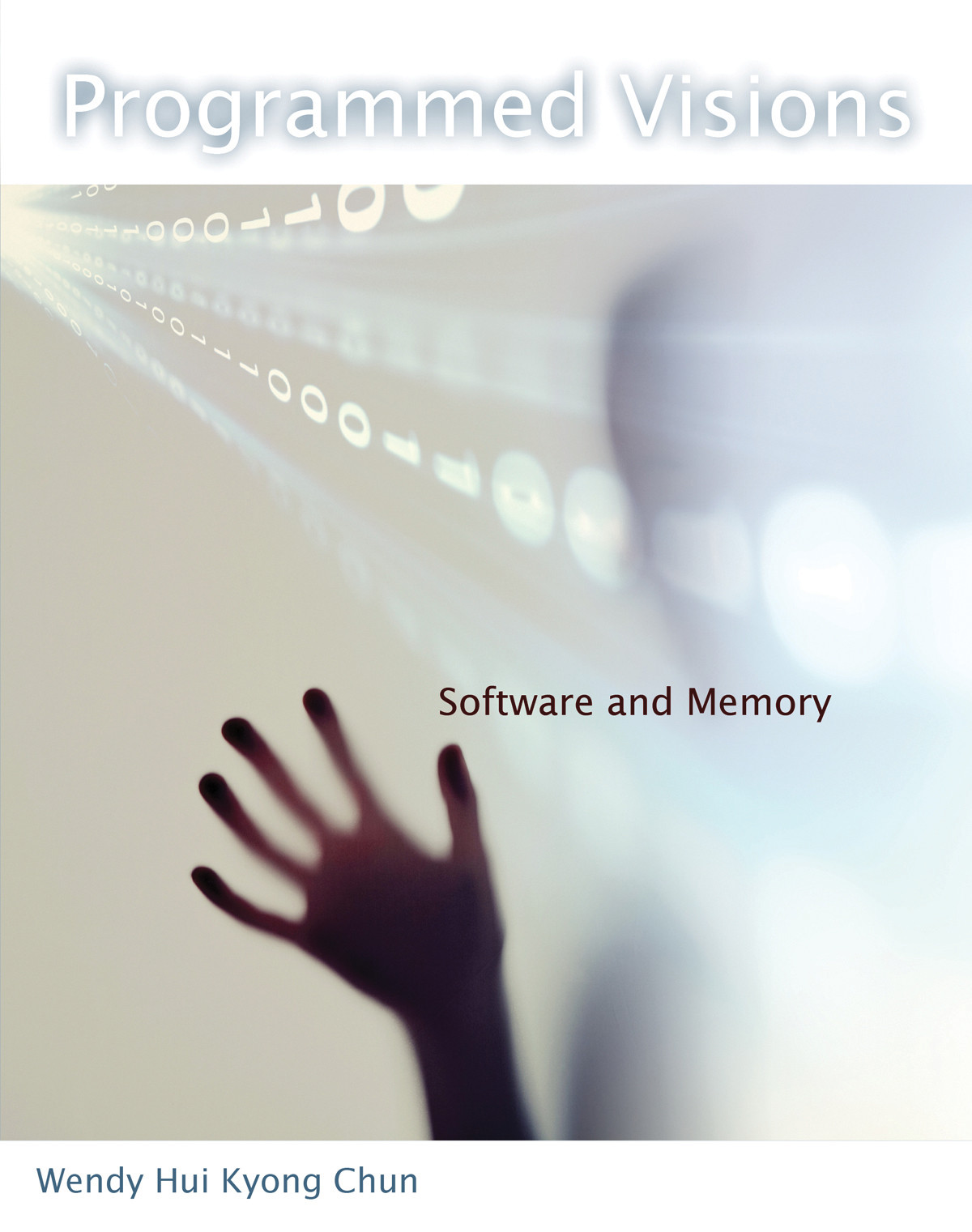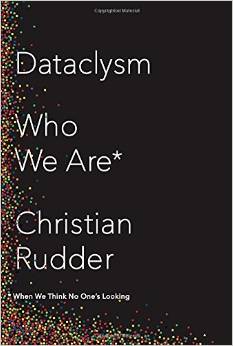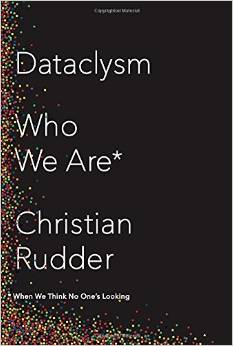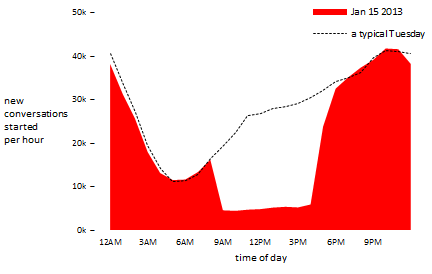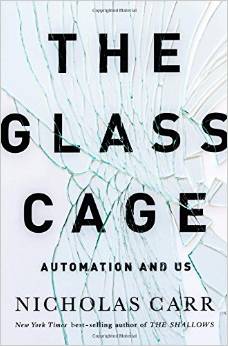 a review of Nicholas Carr, The Glass Cage: Automation and Us (W.W. Norton, 2014)
a review of Nicholas Carr, The Glass Cage: Automation and Us (W.W. Norton, 2014)
by Mike Bulajewski
~
Debates about digital technology are often presented in terms of stark polar opposites: on one side, cyber-utopians who champion the new and the cutting edge, and on the other, cyber-skeptics who hold on to obsolete technology. The framing is one-dimensional in the general sense that it is superficial, but also in a more precise and mathematical sense that it implicitly treats the development of technology as linear. Relative to the present, there are only two possible positions and two possible directions to move; one can be either for or against, ahead or behind.[1]
Although often invoked as a prelude to transcending the division and offering a balanced assessment, in describing the dispute in these pro or con terms one has already betrayed one’s orientation, tilting the field against the critical voice by assigning it an untenable position. Criticizing a new technology is misconstrued as a simple defense of the old technology or of no technology, which turns legitimate criticism into mere conservative fustiness, a refusal to adapt and a failure to accept change.
Few critics of technology match these descriptions, and those who do, like the anarcho-primitivists who claim to be horrified by contemporary technology, nonetheless accede to the basic framework set by technological apologists. The two sides disagree only on the preferred direction of travel, making this brand of criticism more pro-technology than it first appears. One should not forget that the high-tech futurism of Silicon Valley is supplemented by the balancing counterweight of countercultural primitivism, with Burning Man expeditions, technology-free Waldorf schools for children of tech workers, spouses who embrace premodern New Age beliefs, romantic agrarianism, and restorative digital detox retreats featuring yoga and meditation. The diametric opposition between pro- and anti-technology is internal to the technology industry, perhaps a symptom of the repression of genuine debate about the merits of its products.
***
Nicholas Carr’s most recent book, The Glass Cage: Automation and Us, is a critique of the use of automation and a warning of its human consequences, but to conclude, as some reviewers have, that he is against automation or against technology as such is to fall prey to this one-dimensional fallacy.[2]
The book considers the use of automation in areas like medicine, architecture, finance, manufacturing and law, but it begins with an example that’s closer to home for most of us: driving a car. Transportation and wayfinding are minor themes throughout the book, and with Google and large automobile manufacturers promising to put self-driving cars on the street within a decade, the impact of automation in this area may soon be felt in our daily lives like never before. Early in the book, we are introduced to problems that human factors engineers working with airline autopilot systems have discovered and may be forewarnings of a future of the unchecked automating of transportation.
Carr discusses automation bias—the tendency for operators to assume the system is correct and external signals that contradict it are wrong—and the closely related problem of automation complacency, which occurs when operators assume the system is infallible and so abandon their supervisory role. These problems have been linked to major air disasters and are behind less-catastrophic events like oblivious drivers blindly following their navigation systems into nearby lakes or down flights of stairs.
The chapter dedicated to deskilling is certain to raise the ire of skeptical readers because it begins with an account of the negative impact of GPS technology on Inuit hunters who live in the remote northern reaches of Canada. As GPS devices proliferated, hunters lost what a tribal elder describes as “the wisdom and knowledge of the Inuit”: premodern wayfinding methods that rely on natural phenomena like wind, stars, tides and snowdrifts to navigate. Inuit wayfinding skills are truly impressive. The anthropologist Claudio Aporta reports traveling with a hunter across twenty square kilometers of flat featureless land as he located seven fox traps that he had never seen before, set by his uncle twenty five years prior. These talents have been eroded as Inuit hunters have adopted GPS devices that seem to do the job equally well, but have the unexpected side effect of increasing injuries and deaths as hunters succumb to equipment malfunctions and the twin perils of automation complacency and bias.
Laboring under the misconceptions of the one-dimensional fallacy, it would be natural to take this as a smoking gun of Carr’s alleged anti-technology perspective and privileging of the premodern, but the closing sentences of the chapter point us away from that conclusion:
We ignore the ways that software programs and automated systems might be reconfigured so as not to weaken our grasp on the world but to strengthen it. For, as human factors researchers and other experts on automation have found, there are ways to break the glass cage without losing the many benefits computers grant us. (151)
These words segue into the following chapter, where Carr identifies the dominant philosophy that designs automation technologies to inadvertently produce problems that he identified earlier: technology-centered automation. This approach to design is distrustful of humans, perhaps even misanthropic. It views us as weak, inefficient, unreliable and error-prone, and seeks to minimize our involvement in the work to be done. It institutes a division of labor between human and machine that gives the bulk of the work over to the machine, only seeking human input in anomalous situations. This philosophy is behind modern autopilot systems that hand off control to human pilots for only a few minutes in a flight.
The fundamental argument of the book is that this design philosophy can lead to undesirable consequences. Carr seeks an alternative he calls human-centered automation, an approach that ensures the human operator remains engaged and alert. Autopilot systems designed with this philosophy might return manual control to the pilots at irregular intervals to ensure they remain vigilant and practice their flying skills. It could provide tactile feedback of its operations so that pilots are involved in a visceral way rather than passively monitoring screens. Decision support systems like those used in healthcare could take a secondary role of reviewing and critiquing a decision made by a doctor made rather than the other way around.
The Glass Cage calls for a fundamental shift in how we understand error. Under the current regime, an error is an inefficiency or an inconvenience, to be avoided at all costs. As defined by Carr, a human-centered approach to design treats error differently, viewing it as an opportunity for learning. He illustrates this with a personal experience of repeatedly failing a difficult mission in the video game Red Dead Redemption, and points to the satisfaction of finally winning a difficult game as an example of what is lost when technology is designed to be too easy. He offers video games as a model for the kinds of technologies he would like to see: tools that engage us in difficult challenges, that encourage us to develop expertise and to experience flow states.
But Carr has an idiosyncratic definition of human-centered design which becomes apparent when he counterposes his position against the prominent design consultant Peter Merholz. Echoing premises almost universally adopted by designers, Merholz calls for simple, frictionless interfaces and devices that don’t require a great deal of skill, memorization or effort to operate. Carr objects that that eliminates learning, skill building and mental engagement—perhaps a valid criticism, but it’s strange to suggest that this reflects a misanthropic technology-centered approach.
A frequently invoked maxim of human-centered design is that technology should adapt to people, rather than people adapting to technology. In practice, the primary consideration is helping the user achieve his or her goal as efficiently and effectively as possible, removing unnecessary obstacles and delays that stand in the way. Carr argues for the value of challenges, difficulties and demands placed on users to learn and hone skills, all of which fall under the prohibited category of people adapting to technology.
In his example of playing Red Dead Redemption, Carr prizes the repeated failure and frustration before finally succeeding at the game. From the lens of human-centered design, that kind of experience is seen as a very serious problem that should be eliminated quickly, which is probably why this kind of design is rarely employed at game studios. In fact, it doesn’t really make sense to think of a game player as having a goal, at least not from the traditional human-centered standpoint. The driver of a car has a goal: to get from point A to point B; a Facebook user wants to share pictures with friends; the user of a word processor wants to write a document; and so on. As designers, we want to make these tasks easy, efficient and frictionless. The most obvious way of framing game play is to say that the player’s goal is to complete the game. We would then proceed to remove all obstacles, frustrations, challenges and opportunities for error that stand in the way so that they may accomplish this goal more efficiently, and then there would be nothing left for them to do. We would have ruined the game.
This is not necessarily the result of a misanthropic preference for technology over humanity, though it may be. It is also the likely outcome of a perfectly sincere and humanistic belief that we shouldn’t inconvenience the user with difficulties that stand in the way of their goal. As human factors researcher David Woods puts it, “The road to technology-centered systems is paved with human-centered intentions,”[3] a phrasing which suggests that these two philosophies aren’t quite as distinct as Carr would have us believe.
Carr’s vision of human-centered design differs markedly from contemporary design practice, which stresses convenience, simplicity, efficiency for the user and ease of use. In calling for less simplicity and convenience, he is in effect critical of really existing human-centeredness, and that troubles any reading of The Glass Cage that views it a book about restoring our humanity in a world driven mad by machines.
It might be better described as a book about restoring one conception of humanity in a world driven mad by another. It is possible to argue that the difference between the two appears in psychoanalytic theory as the difference between drive and desire. The user engages with a technology in order to achieve a goal because they perceive themselves as lacking something. Through the use of this tool, they believe they can regain it and fill in this lack. It follows that designers ought to help the user achieve their goal—to reach their desire—as quickly and efficiently as possible because this will satisfy them and make them happy.
But the insight of psychoanalysis is that lack is ontological and irreducible, it cannot be filled in any permanent way because any concrete lack we experience is in fact metonymic for a constitutive lack of being. As a result, as desiring subjects we are caught in an endless loop of seeking out that object of desire, feeling disappointed when we find it because it didn’t fulfill our fantasies and then finding a new object to chase. The alternative is to shift from desire to drive, turning this failure into a triumph. Slavoj Žižek describes drive as follows: “the very failure to reach its goal, the repetition of this failure, the endless circulation around the object, generates a satisfaction of its own.”[4]
This satisfaction is perhaps what Carr aims at when he celebrates the frustrations and challenges of video games and of work in general. That video games can’t be made more efficient without ruining them indicates that what players really want is for their goal to be thwarted, evoking the psychoanalytic maxim that summarizes the difference between desire and drive: from the missing/lost object, to loss itself as an object. This point is by no means tangential. Early on, Carr introduces the concept of miswanting, defined as the tendency to desire what we don’t really want and won’t make us happy—in this case, leisure and ease over work and challenge. Psychoanalysts holds that all human wanting (within the register of desire) is miswanting. Through fantasy, we imagine an illusory fullness or completeness of which actual experience always falls short.[5]
Carr’s revaluation of challenge, effort and, ultimately, dissatisfaction cannot represent a correction of the error of miswanting–of rediscovering the true source of pleasure and happiness in work. Instead, it radicalizes the error: we should learn to derive a kind of satisfaction from our failure to enjoy. Or, in the final chapter, as Carr says of the farmer in Robert Frost’s poem Mowing, who is hard at work and yet far from the demands of productivity: “He’s not seeking some greater truth beyond the work. The work is the truth.”
***
Nicholas Carr has a track record of provoking designers to rethink their assumptions. With The Shallows, along with other authors making related arguments, he influenced software developers to create a new class of tools that cut off the internet, eliminate notifications or block social media web sites to help us concentrate. Starting with OS X Lion in 2011, Apple began offering a full screen mode that hides distracting interface elements and background windows from inactive applications.
What transformative effects could The Glass Cage have on the way software is designed? The book certainly offers compelling reasons to question whether ease of use should always be paramount. Advocates for simplicity are rarely challenged, but they may now find themselves facing unexpected objections. Software could become more challenging and difficult to use—not in the sense of a recalcitrant WiFi router that emits incomprehensible error codes, but more like a game. Designers might draw inspiration from video games, perhaps looking to classics like the first level of Super Mario Brothers, a masterpiece of level design that teaches the fundamental rules of the game without ever requiring the player to read the manual or step through a tutorial.
Everywhere that automation now reigns, new possibilities announce themselves. A spell checker might stop to teach spelling rules, or make a game out of letting the user take a shot at correcting mistakes it has detected. What if there was a GPS navigation device that enhanced our sense of spatial awareness rather than eroding it, that engaged our attention on to the road rather than let us tune out. Could we build an app that helps drivers maintain good their skills by challenging them to adopt safer and more fuel-efficient driving techniques?
Carr points out that the preference for easy-to-use technologies that reduce users’ engagement is partly a consequence of economic interests and cost reduction policies that profit from the deskilling and reduction of the workforce, and these aren’t dislodged simply by pressing for new design philosophies. But to his credit, Carr has written two best-selling books aimed at the general interest reader on the fairly obscure topic of human-computer interaction. User experience designers working in the technology industry often face an uphill battle in trying to build human-centered products (however that is defined). When these matters attract public attention and debate, it makes their job a little easier.
_____
Mike Bulajewski (@mrteacup) is a user experience designer with a Master’s degree from University of Washington’s Human Centered Design and Engineering program. He writes about technology, psychoanalysis, philosophy, design, ideology & Slavoj Žižek at MrTeacup.org. He has previously written about the Spike Jonze film Her for The b2 Review Digital Studies section.
_____
[1] Differences between individual technologies are ignored and replaced by the monolithic master category of Technology. Jonah Lehrer’s review of Nicholas Carr’s 2010 book The Shallows in the New York Times exemplifies such thinking. Lehrer finds contradictory evidence against Carr’s argument that the internet is weakening our mental faculties in scientific studies that attribute cognitive improvements to playing video games, a non sequitur which gains meaning only by subsuming these two very different technologies under a single general category of Technology. Evgeny Morozov is one of the sharpest critics of this tendency. Here one is reminded of his retort in his article “Ghosts in the Machine” (2013): “That dentistry has been beneficial to civilization tells us very little about the wonders of data-mining.”
[2] There are a range of possible causes for this constrictive linear geometry: a tendency to see a progressive narrative of history; a consumerist notion of agency which only allows shoppers to either upgrade or stick with what they have; or the oft-cited binary logic of digital technology. One may speculate about the influence of the popular technology marketing book by Geoffrey A. Moore, Crossing the Chasm (2014) whose titular chasm is the gap between the elite group of innovators and early adopters—the avant-garde—and the recalcitrant masses bringing up the rear who must be persuaded to sign on to their vision.
[3] David D. Woods and David Tinapple (1999). “W3: Watching Human Factors Watch People at Work.” Proceedings of the 43rd Annual Meeting of the Human Factors and Ergonomics Society (1999).
[4] Slavoj Žižek, The Parallax View (2006), 63.
[5] The cultural and political implications of this shift are explored at length in Todd McGowan’s two books The End of Dissatisfaction: Jacques Lacan and the Emerging Society of Enjoyment (2003) and Enjoying What We Don’t Have: The Political Project of Psychoanalysis (2013).






